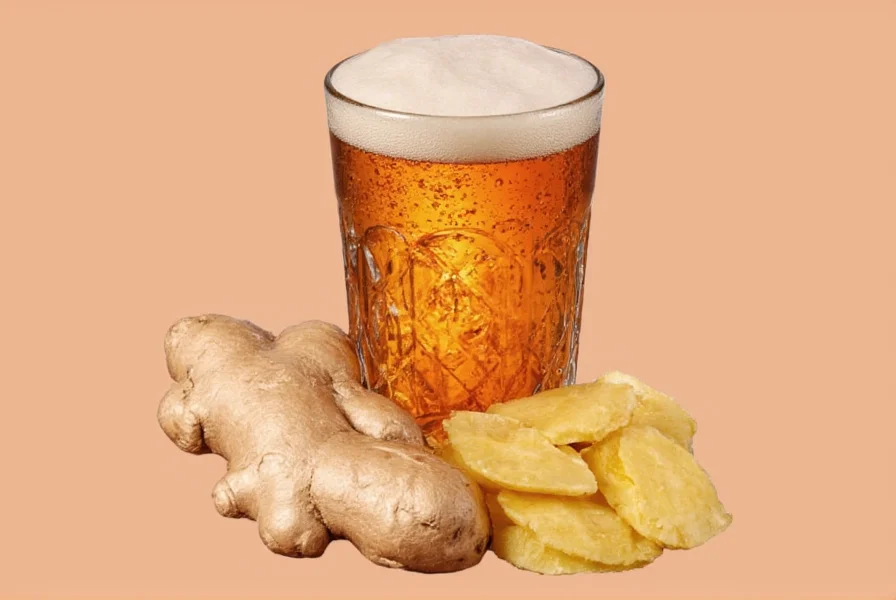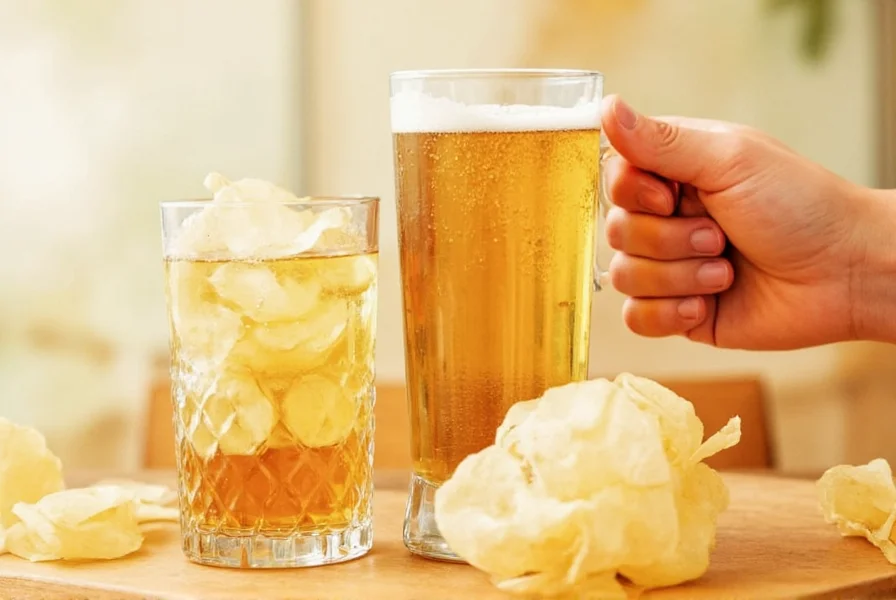For centuries, ginger has been used as a natural remedy for digestive discomfort. While modern medicine offers pharmaceutical options for nausea relief, many people still reach for ginger ale when feeling queasy. But what makes this carbonated beverage effective against nausea? The answer lies in the science of ginger's active components and their physiological effects.
The Active Compounds in Ginger
Ginger contains several bioactive compounds that contribute to its anti-nausea properties. The most significant are:
| Compound | Natural Source | Anti-Nausea Mechanism |
|---|---|---|
| Gingerols | Fresh ginger root | Modulate serotonin receptors in the gut |
| Shogaols | Dried or cooked ginger | Reduce inflammation in digestive tract |
| Zingerone | Processed ginger products | Antioxidant properties that calm stomach |
These compounds work synergistically to address nausea through multiple pathways. Gingerols, the predominant compounds in fresh ginger, interact with 5-HT3 serotonin receptors in the gastrointestinal tract. These same receptors are targeted by prescription anti-nausea medications like ondansetron. By modulating these receptors, ginger helps reduce the signals that trigger nausea and vomiting.
How Ginger Affects the Digestive System
Research shows ginger influences several physiological processes that contribute to nausea relief:
- Gastric motility regulation: Ginger helps normalize stomach contractions, preventing the irregular movements that often precede nausea
- Anti-inflammatory effects: Ginger compounds reduce inflammation in the digestive tract that can trigger nausea
- Antioxidant properties: These help protect gastrointestinal tissues from irritation
- Central nervous system effects: Some compounds may influence brain pathways related to nausea
A 2020 review published in Nutrients analyzed multiple clinical trials and concluded that ginger supplementation significantly reduced nausea symptoms across various conditions compared to placebo. The researchers noted ginger's effectiveness appears comparable to some conventional antiemetic medications for certain types of nausea.

Ginger Ale vs. Other Ginger Preparations
Not all ginger products offer equal nausea relief. The effectiveness of ginger ale depends on several factors:
- Ginger content: Traditional ginger ales contained substantial ginger root extract, but many modern commercial versions use artificial ginger flavor with minimal actual ginger
- Sugar content: High sugar levels in some ginger ales might actually worsen nausea for certain individuals
- Carbonation: The bubbles may help settle the stomach for some people but cause discomfort for others
For maximum benefit when using ginger ale for nausea relief, look for brands that list "real ginger" or "ginger root extract" high in the ingredients. "Does ginger ale really help with upset stomach" depends largely on the product's actual ginger content. Many health professionals recommend fresh ginger tea or ginger chews as more reliable alternatives since they contain higher concentrations of active compounds.
Scientific Evidence for Ginger's Anti-Nausea Effects
Multiple studies have investigated ginger's effectiveness for various types of nausea:
- Pregnancy-related nausea: A 2014 study in Obstetrics & Gynecology found ginger significantly reduced nausea severity in pregnant women compared to placebo
- Post-operative nausea: Research in Anesthesia & Analgesia demonstrated ginger reduced post-surgical nausea by 38% compared to control groups
- Chemotherapy-induced nausea: Several studies show ginger supplementation alongside standard medications improves nausea control
- Travel sickness: Evidence suggests ginger may be as effective as dimenhydrinate (Dramamine) for motion sickness prevention
The scientific reason ginger ale helps nausea relates to these well-documented physiological effects. However, effectiveness varies by individual and by the specific cause of nausea. Ginger appears most effective for mild to moderate nausea rather than severe vomiting episodes.

Practical Recommendations for Using Ginger
If you're considering ginger for nausea relief, keep these evidence-based recommendations in mind:
- For best results, consume 1-1.5 grams of ginger (about 1/4 to 1/2 teaspoon of powdered ginger) when nausea symptoms begin
- Fresh ginger preparations generally contain higher concentrations of active compounds than processed products
- Allow 20-30 minutes for ginger to take effect; it's not an immediate remedy
- Consider ginger supplements standardized for gingerol content if using regularly
- Consult your healthcare provider before using ginger if you have gallstones or are taking blood thinners
The best ginger ale for nausea relief typically contains at least 100-200mg of ginger per serving. Reading ingredient labels carefully can help identify products with sufficient ginger content. Some specialty brands specifically formulate their ginger ale for medicinal use with higher ginger concentrations and lower sugar content.
When to Seek Medical Attention
While ginger provides relief for many cases of mild nausea, certain symptoms warrant medical evaluation:
- Nausea lasting more than 48 hours without improvement
- Severe vomiting that prevents keeping liquids down
- Nausea accompanied by chest pain, severe headache, or neurological symptoms
- Blood in vomit or black, tarry stools
- Symptoms that significantly interfere with daily activities
Chronic or severe nausea may indicate underlying conditions requiring medical treatment. Ginger works well as a complementary approach but shouldn't replace professional medical care when needed.
Conclusion
The effectiveness of ginger ale for nausea stems from ginger's bioactive compounds that interact with the digestive system in multiple beneficial ways. While not all commercial ginger ales contain sufficient ginger to provide significant relief, those with adequate ginger content can offer a natural, evidence-based option for managing mild nausea. Understanding how does ginger ale help with nausea helps consumers make informed choices about which products might provide genuine relief versus those that offer little more than carbonated sugar water.
Frequently Asked Questions
How quickly does ginger ale work for nausea?
Ginger ale typically begins working within 20-30 minutes after consumption. The active compounds in ginger need time to be absorbed and interact with the digestive system. For best results, sip slowly rather than drinking it all at once. Effectiveness depends on the actual ginger content in the product, with higher-quality ginger ales containing real ginger root extract providing faster relief than those with artificial flavoring.
Is there a difference between regular and diet ginger ale for nausea?
The primary difference lies in the sugar content. Regular ginger ale contains sugar which might help stabilize blood sugar levels contributing to nausea relief for some people, while diet versions use artificial sweeteners which could potentially worsen nausea in sensitive individuals. However, the critical factor is the actual ginger content, which varies more between brands than between regular and diet versions of the same brand. When choosing ginger ale for nausea relief, prioritize products with real ginger extract regardless of sugar content.
Can children use ginger ale for nausea?
Yes, ginger ale can be used for children's nausea, but with some considerations. For children under 2 years, consult a pediatrician first. Older children can typically have small amounts (2-4 ounces) of ginger ale with adequate ginger content. Avoid products with high sugar content which might worsen dehydration if vomiting occurs. Some parents prefer ginger tea or ginger chews for children as they can better control the ginger dosage without excessive sugar. Always monitor children for any adverse reactions.
Why does ginger ale help nausea but other sodas don't?
Ginger ale's effectiveness comes specifically from the ginger compounds, not from being a carbonated beverage. Other sodas lack the bioactive gingerols and shogaols that interact with serotonin receptors and reduce inflammation in the digestive tract. While the carbonation in ginger ale might provide some soothing effect for certain individuals, research shows it's the ginger content that provides the anti-nausea benefits. Sodas without ginger don't contain these specific compounds that make ginger effective against nausea.
How much ginger should be in ginger ale to help with nausea?
For ginger ale to be effective for nausea relief, it should contain at least 100-200mg of ginger root extract per 8-ounce serving. Many commercial brands contain significantly less, sometimes as little as 2-10mg per serving, which is unlikely to provide therapeutic benefits. Check the ingredient list for "ginger root extract" or "real ginger" near the beginning. Specialty "natural" or "medicinal" ginger ales typically contain higher concentrations. Alternatively, adding fresh ginger slices to regular ginger ale can boost its effectiveness.











 浙公网安备
33010002000092号
浙公网安备
33010002000092号 浙B2-20120091-4
浙B2-20120091-4